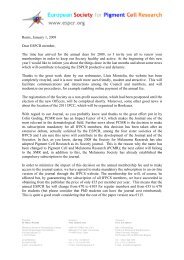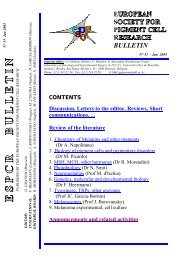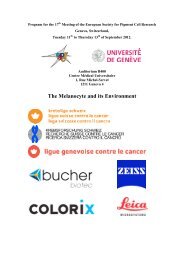espcrbulletin - European Society for Pigment Cell Research
espcrbulletin - European Society for Pigment Cell Research
espcrbulletin - European Society for Pigment Cell Research
You also want an ePaper? Increase the reach of your titles
YUMPU automatically turns print PDFs into web optimized ePapers that Google loves.
LETTER TO THE EDITOR<br />
DISCUSSION, REVIEW,<br />
SHORT COMMUNICATION, ...<br />
A Jubilee Year <strong>for</strong> Two Famous Scientists and<br />
Distinguished ESPCR Members<br />
By Jan Borovanský<br />
This year two legends of the ESPCR have reached important anniversaries. They both<br />
originated from families with medical connections and graduated as M.D. They both were born in a<br />
different country from that where they permanently live nowadays. One of them started his career as a<br />
dermatologist to become top scientist in the field of pigment cell research and cell pathology, the other<br />
at first was a biochemist interested in<br />
melanogenesis and melanogens to<br />
become first class dermatologist and<br />
photobiologist. They share both a<br />
common interest in the toxicity of<br />
melanin precursors and a great hobby<br />
in per<strong>for</strong>ming music. As students they<br />
both played in the collegiate jazz<br />
bands as a clarinet and alto saxophone<br />
and clarinet players, respectively.<br />
They share a common weakness <strong>for</strong><br />
the piano and both of them are my<br />
best friends. I introduced them to each<br />
other on December 5, 1984.<br />
Professor Patrick Anthony Riley, M.B., B.S., Ph.D., D.Sc., F.I. Biol., F.R.C. Pathol. Was born on<br />
22nd March 1935 in Neuilly-sur-Seine, France. His father Bertrand Hurrell Riley belonged to founders<br />
of the World Health Organization and spent many years in Geneva. Patrick Riley visited him regularly<br />
during holidays because he studied at a boarding school in the U.K. From childhood he has had a deep<br />
fascination <strong>for</strong> the way things work which can be illustrated e.g. by a set of magnets and one-penny<br />
coins he developed much later in his adulthood <strong>for</strong> a commercial purpose to teach children the<br />
phenomenon of magnetism in a playful way. He has always been interested in and fascinated by<br />
mechanisms of biological phenomena and his preoccupation in living cells was deepened and<br />
„saturated“ by many prominent teachers, scientists and friends, especially at the University College<br />
London, which was a powerhouse of biological learning. During medical studies he met his charming<br />
wife and life-long supporter, Christine. After graduation from University College Hospital Medical<br />
School (UCHMS) in 1960 he spent a half year as a house-physician in the Department of<br />
Dermatology and later, having obtained a Rockefeller scholarship, he joined Dr. Arthur Jarrett in the<br />
Department of Dermatological Histopathology at UCHMS where he started his research activities by<br />
studying various enzyme activities in dendritic epidermal cells. He was awarded a Medical <strong>Research</strong><br />
Council Junior Clinical <strong>Research</strong> Fellowship and pursued studies of epidermal depigmentation and the<br />
relationship between melanocytes and Langerhans cells. In 1965 he obtained his Ph.D. having<br />
defended a thesis entitled Studies of Melanocyte Function and co-authored a textbook of dermatology.<br />
In 1966 he was awarded a Beit Memorial Fellowship and moved to the Department of Pathological<br />
Chemistry where he shared an office with Trevor Slater, a brilliant and enthusiastic biochemist and<br />
advocate of free radical reactions. I suppose that this famous pioneer of free radical research ignited in<br />
Patrick Riley his permanent fascination <strong>for</strong> free radical reactions <strong>for</strong> in the same year the seminal<br />
1403







